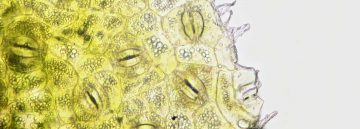
There are two phases in which water moves:
- from soil to root
- from root to leaf.
Water movement from soil to root is largely due to osmosis. The solute concentration in the root is higher than the solute concentration in the soil, and water moves from the low concentration to the higher concentration.
Active pumping creates and maintains this concentration difference with ions pumped into the cell. Active transport describes what happens when a cell uses energy to transport ions in this way.
Water movement from the root to the leaf is primarily explained by the cohesion-tension theory. The driving force of this movement is transpiration, that is, the evaporation of water from the leaf surface. Water molecules cohere (stick together), and are pulled up the plant by the tension, or transpiration pull, exerted by evaporation at the leaf surface. ATP is not needed for this process.
Root pressure due to osmosis also plays a role in driving water from the root to the leaf. In the root there is a high concentration of solute. When water comes into the root, the pressure builds. Water is driven up the plant as a result. Evidence of this can be found in guttation, which is where water is extruded out through the leaf due to root pressure. (The image above shows guttation in strawberry leaves – image by Noah Elhardt.)
Water is transported by either apoplastic transportation or symplastic transportation. Apoplastic transport occurs when water is transported between cells up to the endodermis. Symplastic transport occurs when water is transported through the plasma membrane and cytoplasm. Water following this route may take longer to transport and may require energy (ATP). Symplastic transport can pass through the endodermis whereas apoplastic transport cannot.
Material and water must be transported through the endodermis symplastically, because the endodermis is relatively impermeable. After water is brought into the vascular bundle, transfer cells take the material from the cell cytoplasm and transport it to the xylem.


